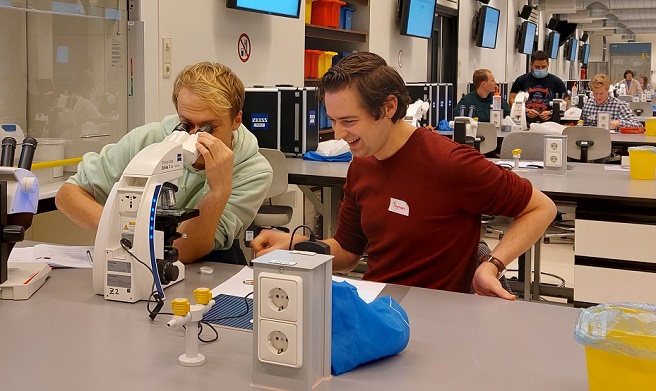
Record number of registrations for PhD course microscopy
‘Microscopy is by far the least understood, most inefficiently operated, and the most abused of all laboratory instruments,’ reads the quote on the office wall of microscopy unit supporters Joost Willemse en Gerda Lamers. It describes exactly why the two developed the microscopy course for starting PhD candidates.
Willemse and Lamers organize the course for the fifth time. The course is not just for PhD’ers and post-docs of the Institute of Biology Leiden (IBL), but that of other institutes too – such as LACDR, LIC and LION. Again, they received a record number of registrations. In the first year, just 30 persons enrolled to the course, while this year there were 66. However, due to corona measures only 40 people could take part.
From light’s origin to electron microscope
‘We have a wide range of microscopes in our unit. We want that people know the characteristics of each microscope and which would be most suited for their type of research,’ Willemse says about the aim of the course. ‘To achieve that, they have to know how each microscope works, what you can do with it and how properly set it up. Then they know how to efficiently make the best possible images that are most useful for their research.’
During the weeklong course, all available light microscopes are discussed in short order. Willemse and Lamers start with the origin of light and how microscopes use light, then explain each pro and con of the microscopes. Additionally, they discuss the preparations of samples and contrast techniques which will eventually facilitate and improve doing research.
-

Starting PhD Candidates at the beginnen of the course -

Starting PhD Candidates at the beginnen of the course -

One of the pictures taken during the course with a confocal microscope
Guidelines for more focused research
Lamers notices that the course has some real added value for the PhD candidates and post-docs. ‘Sometimes, new researchers don’t know where to start with microscopy. Even though at our IBL around 80 percent needs it in their research. After the course, researchers still have questions for us – and that is a good thing too – but the questions are more focused. The course offers guidelines to optimally use microscopes and learn which microscope you can use in different cases. Because of that, they save time to do other experiments.’
Willemse adds: ‘Another element is that they learn techniques they knew nothing of yet, but that gives better results than what they used previously. Even to discover these possibilities, it’s advantageous to do the course.
What do the PhD Candidates think
Three PhD candidates of LACDR just started at their institute. Bend over their microscopes to check whether everyone counts the same number of dots, they tell that they have not learned a lot about microscopes in previous studies. ‘But now, we will focus on microscopes that are interesting and give us a lot of opportunity in our research,’ one of them says. Also Maarten Lubbers, starting PhD candidate at IBL, is happy to participate: ‘This course teaches several new skills. Even with this light microscope: I finally know the purpose of all its buttons. So besides the fact that it is very interesting, I think this will help my research later on.’
